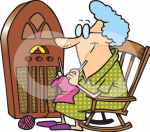Background
No story about Shortwave broadcasting from Australia would
be complete without reference to the beginnings of local Australian broadcasting, and this summary should be of interest to
readers of this Project.
1921
Charles
MacLurcan was issued with the very first radio licence in Australia for station 2CM. This was broadcast from
the Wentworth Hotel in Sydney, owned by the MacLurcan family, and Charles broadcast popular classical music concerts every
Sunday night.
Radio 2CM was the first radio station in Australia to publish a regular program
guide and Charles was clearly good at generating publicity, because his first broadcast resulted in over 2000 letters from
enthusiastic listeners.
If you look at most histories of Australian
radio, you won’t find mention of 2CM, nor will you find mention of almost 50 other radio stations that were on the air
in1921 and 1922 – well before 2SB was granted the first commercial licence in 1923 and then changed its call sign to
2BL in 1924.
In fact 2CM could trace
its heritage back to a morse code station, XDM, which began broadcasting in 1911 and established numerous long distance records
such as being heard in New Zealand with a power of 0.0037 watts.
1923
Following intensive lobbying for the introduction of radio broadcasting, the
Government, in May 1923, called a conference of the main players in the radio manufacturing industry. This led to the sealed
set regulations where stations could be licensed to broadcast and then sell sets to 'listeners-in'. The receiving device would
be set to receive only that station.
2FC in Sydney was the first radio station to be licensed on 10 September 1923
(going to air officially on 9 January 1924), but its opponent 2SB (later to be called 2BL) was first to go to air officially
starting on 23 November 1923.
1924
3AR and 3LO went to air on 26 January and 13 October 1924 in Melbourne.
The Government introduced
a two-tiered licence system in July 1924. In the first half of 1924, only 1400 people took out sealed set licences. It was
quite easy for listeners to avoid the licence fee by building their own sets or modifying one they had bought to receive more
than one station.
The radio industry successfully lobbied the Government to introduce a two-tiered system, the 'A'
licences to be financed by listeners' licence fees imposed and collected by the Government, and 'B' class licences to be offered
to anyone else who wanted to have a go. The B stations would have to generate their own revenue through advertising. A class
stations could also advertise but few did.
This system was an amalgam of the British system where the non-commercial
BBC had a government-imposed monopoly and the USA where the free market was the driving force.
The 'A' class stations
were the original sealed set stations plus one in each other capital city - 2BL, 2FC, 3AR, 3LO, 7ZL, 5CL, 6WF. By years end,
40,000 licences have been issued.
The
first 'B' class station on air was 2BE in November 1924
South Australia’s
first radio station 5CL (A class) went to air on
November 20.
1925
The
oldest surviving 'B' class (commercial) station is 2UE which went on air on Australia Day
-
3UZ Melbourne began broadcasting
-
South Australia’s
first commercial radio station 5DN went to air February 24
-
Number of licences issued
reached 80,000.
1926
The
British Government nationalised radio by buying out the British Broadcasting Company and forming the British Broadcasting
Corporation. The Australian Government held a Royal Commission into Wireless but didn't immediately follow the British lead. It did encourage
the 'A' class stations to amalgamate in order to maximise efficiencies and maintain standards.
3DB Melbourne commenced broadcasting
1929
2BE
closed due to financial collapse.
The Government nationalises the transmission facilities and contracts the provision
of programming to the Australian Broadcasting Company (now Australian Broadcasting Corporation), a consortium of entertainment
interests.
1932
The
Australian
Broadcasting Company was nationalised by the Australian Broadcasting
Commission Act (1932). This finalised the two-tier system with the national broadcaster, the newly created Australian Broadcasting
Commission, having 12 stations, and the commercial sector, with 43 stations.
The ABC
was funded by listeners’ licence fees until the 1970s, when Federal Government appropriation became the primary source
of funding. Initial plans to permit advertising on the ABC were dropped from the final bill presented to the parliament
On
29 June 29 1932, 2WG in Wagga Wagga, New
South Wales went on the air on a purpose-built 2000 watt transmitter.
At 8.00 pm on July 1 1932, the
Prime Minister, Joseph Lyons, inaugurated the ABC. It then controlled 12 stations – 2FC and 2BL in Sydney, 3AR and 3LO in Melbourne, 4QG in Brisbane, 5CL in Adelaide, 6WF in Perth, 7ZL in Hobart and the relay stations 2NC in Newcastle, New
South Wales, 2CO at Corowa, New South
Wales, 4RK in Rockhampton, Queensland and 5CK at Crystal Brook,
South Australia.

